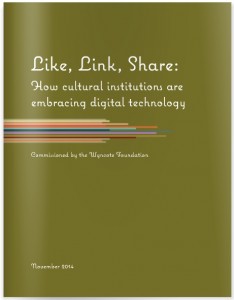 New research proves that established and traditional cultural institutions–museums, orchestras and libraries–are adjusting to a new digital reality. Looking to accommodate the public expectation of engaging with culture without sitting through a long performance or attending an exhibit, these legacy institutions are changing traditional ways of thinking and operating.
New research proves that established and traditional cultural institutions–museums, orchestras and libraries–are adjusting to a new digital reality. Looking to accommodate the public expectation of engaging with culture without sitting through a long performance or attending an exhibit, these legacy institutions are changing traditional ways of thinking and operating.
The Wyncote Foundation commissioned report, which came out last November, titled “Like, Link, Share: How Cultural Organizations are Embracing Digital Technology,” presents five themes that explain how digital innovation sparks “not only ‘cool new project’ but also fundamental changes in the orientation of legacy institutions.”
ONE: Strategy: Know the Game Plan
Organizations are ensuring that their digital strategies are an integral part of their overall strategy. The report shows that a coherent digital strategy can help an institution’s decision-making and evaluation, by utilizing such means as social media pages, blogs, app development and fundraising. For example, the Philharmonia, a London based orchestra, aimed to “create new audience experiences with classical music” using digital tools. To evaluate its success, the Philharmonia examines a breakdown of its online reach and number of visits to its website.
TWO: Build Capabilities Not Projects
Striving for ‘new capabilities’ means that these institutions are taking on new projects that build long-term capacities and meant to sustain future operations. Institutions demonstrate this most commonly by working prudently towards digitizing their archives, not tackling the assignment all at once, rather working on specific aspects such as an artist or an era, based on limited grants and funds. Another example is institutions choosing to hire a full-time media teams rather than contractors per project. These long term approaches allow the institutions to monitor a learning curve of their ongoing projects and staff.
THREE: Shake Up The Organisation’s Chart
Shaking the organizational structure refers most often to the addition of a Chief Digital Officer. Such step helps to maintain coordination of digital strategies across the institution. It’s important to remember re-organising the staff is not an easy task, and often debated. But according to the report, it’s an important step forward.
FOUR: Audiences First
It’s the audience expectations that creates the need and urgency for newer digital means of engaging. Institutions should aspire to enhance the audience’s experiences and discussions about the institution online. Institutions have to maintain “a seamless and lively presence on digital channels,” complying with the public’s expectations, aiming to reach audiences outside of their physical venues.
FIVE: Toward New Business Models
The fifth theme in the report explains how new digital tools help organizations and institutions in pursuing new business models and new revenue sources. Focusing on new media consumption habits and on collaboration with the audience, these new models includ online ads, selling online content and crowdfunding.
On the report’s website you can read about different cultural institutions, which have learned how to use digital technology and have evolved into this new area. For example the Detroit Symphony Orchestra, the fourth oldest symphony in the US, increased its revenue by selling the rights to its web-cast concerts, and now reaches audiences online and through a smartphone app. Or the Rijksmuseum in Amsterdam, which launched Rijks Studio where online visitors can create their own collections from the museum’s, share them online and even order merchandise of the images they chosen.
Seeing such esteemed institutions breaking away from traditional ideas, and adapting to the changing times and demands is inspirational. Hopefully other institutions and organisations from different fields will follow as well.
